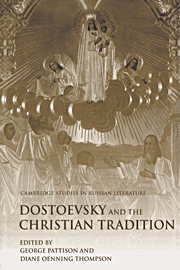Book contents
- Frontmatter
- Contents
- Notes on contributors
- Acknowledgments
- Notes on conventions and abbreviations
- Introduction: Reading Dostoevsky religiously
- PART I DOSTOEVSKY AND THE PRACTICE OF ORTHODOXY
- 1 Dostoevsky and the kenotic tradition
- 2 Dostoevsky's markings in the Gospel according to St John
- 3 Icons in Dostoevsky's works
- 4 Problems of the biblical word in Dostoevsky's poetics
- PART II DOSTOEVSKY AND CHRISTIAN THEOLOGY
- PART III READING DOSTOEVSKY RELIGIOUSLY: CASE STUDIES
- Bibliography
- Index
- CAMBRIDGE STUDIES IN RUSSIAN LITERATURE
3 - Icons in Dostoevsky's works
Published online by Cambridge University Press: 02 December 2009
- Frontmatter
- Contents
- Notes on contributors
- Acknowledgments
- Notes on conventions and abbreviations
- Introduction: Reading Dostoevsky religiously
- PART I DOSTOEVSKY AND THE PRACTICE OF ORTHODOXY
- 1 Dostoevsky and the kenotic tradition
- 2 Dostoevsky's markings in the Gospel according to St John
- 3 Icons in Dostoevsky's works
- 4 Problems of the biblical word in Dostoevsky's poetics
- PART II DOSTOEVSKY AND CHRISTIAN THEOLOGY
- PART III READING DOSTOEVSKY RELIGIOUSLY: CASE STUDIES
- Bibliography
- Index
- CAMBRIDGE STUDIES IN RUSSIAN LITERATURE
Summary
Dostoevsky's world is full of icons. The one which appears most often is the icon of the Mother of God. In the novel A Raw Youth there is an icon representing two saints but we are given no information about them. Sometimes, indeed, the icon is left without a name. Icons are generally located in a church, on the iconostasis or on the walls, in a monastery, in a house, over a bed. They can be removed from their consecrated place, change ownership, go from hand to hand. The presence of icons is never fortuitous in Dostoevsky's works and it is therefore important to determine their role in the plot, and the relationships established between them and the characters. Face to face with the icons the latter reveal their inmost selves, and the effect which the icons will have on them will derive mainly from that attitude. This chapter is a preliminary study which may prepare the ground for a wider and more thorough examination of the so far rather neglected topic of the icons in Dostoevsky's fiction.
There has, of course, been considerable interest in the West in recent years in Russian icons, both as works of art and as epitomising some of the characteristic and most attractive aspects of Orthodox spirituality. Despite this interest, it is probably advisable to remind ourselves of some of the chief aspects of the history and meaning of icons in the Russian Church.
The word ‘icon’ (Russian ikond) itself derives from the Greek eikona, meaning image or portrait. In Russian the word obraz (‘image’) is frequently used together with the word ikona.
- Type
- Chapter
- Information
- Dostoevsky and the Christian Tradition , pp. 51 - 68Publisher: Cambridge University PressPrint publication year: 2001



